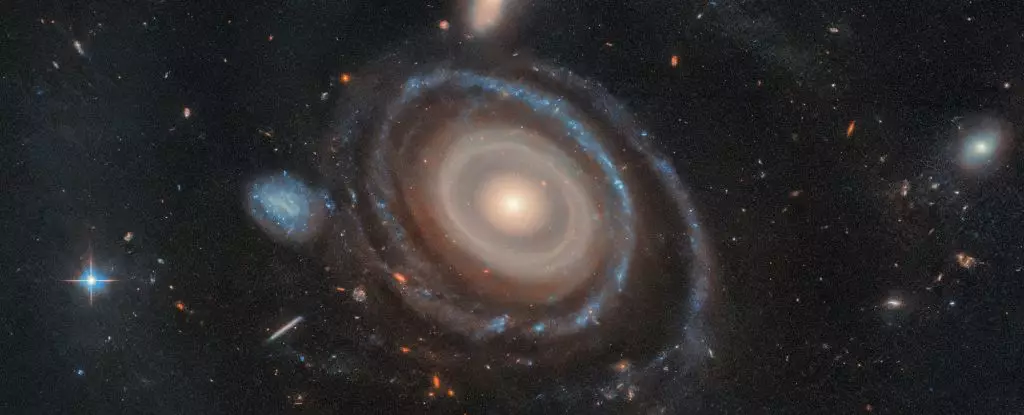In the vastness of the cosmos, each galaxy holds a story, and the uniqueness of these stories is akin to fingerprints in a personal narrative — no two are exactly alike. The discovery of a galaxy that stands out dramatically from its peers has captivated the attention of astronomers: the Bullseye Galaxy, officially labeled as LEDA 1313424. Located approximately 567 million light-years away from Earth, this galaxy is enveloped by an astonishing structure of nine concentric rings. This unprecedented configuration is the aftermath of a significant cosmic event involving a smaller blue dwarf galaxy that passed through its center, creating rippling shockwaves that extended into the fabric of space.
The Bullseye Galaxy offers astronomers a rare glimpse into the aftermath of galactic collisions. The event that led to the formation of these rings occurred relatively recently, in cosmic terms. According to astronomer Pieter van Dokkum from Yale University, this discovery offers a “narrow window” into the life of galaxies post-collision. The presence of multiple rings in a galaxy is an astronomical rarity, indicative of a specific set of circumstances that only occur under certain conditions. This remarkable observation sheds light on how galaxies can influence and reshape one another through gravitational interactions.
Ring galaxies, which bear an unusual structure of circular formations around their cores, are among the rarest types of galaxies observed. Historical examples like Hoag’s Object have intrigued astronomers for years, offering insight into the dynamic interactions of galactic bodies. The formation of these rings is typically the byproduct of one galaxy colliding directly with another, effectively “blasting” through its center. This infers not only a stunning glimpse of cosmic violence but also a complex interplay of forces that propel gas and dust into denser formations, culminating in star formation clusters.
The discovery of the Bullseye Galaxy substantiates theories surrounding this process — it is a tangible testament to celestial mechanics in action. The position of the colliding dwarf galaxy, adjacent to Bullseye, has been accurately mapped using the Hubble Space Telescope and advanced imaging tools like the Keck Cosmic Web Imager (KCWI), optimized for observing in visible blue wavelengths.
One of the pivotal achievements of this discovery is the confirmation that gas is being transferred between the two colliding galaxies. This gas consists of material that, due to the gravitational forces at play, is drawn away, trailing behind the colliding dwarf. This exchange provides critical insights into the methodology behind galactic evolution and transformation. As noted by Imad Pasha, another researcher involved in the study, the identification of the “dart,” or impinging galaxy, has set a precedent in terms of galactic observations, illustrating that material is not simply ejected but rather experiences a complex interaction leading to its re-distribution.
The rings of the Bullseye Galaxy, formed by increased density due to shockwaves, foster regions where star formation can flourish. As gas and dust coalesce in areas of heightened gravitational interaction, stars begin to ignite and cluster within these rings. This phenomenon offers a brilliant visual display, with the rings often appearing brighter and more substantial, reflecting the stellar activity within them. The discoveries made within this unique structure may reshape the scientific understanding of how star formation rates are influenced by galactic interactions.
As a whole, the Bullseye Galaxy serves as a potent case study for theoretical models surrounding galactic evolution and interaction. The spacing of the rings, with their arrangement propagating outward much like the ripples of a stone cast into a pond, poses significant implications for existing theories in astrophysics. This alignment between observation and theoretical prediction reaffirms models of galactic dynamics while urging astronomers to adapt and refine them based on new data.
The future excites researchers with the prospect of employing advanced telescopes and technological innovations to locate additional ring galaxies hidden throughout the universe. Each discovery has the potential to unravel new layers of complexity surrounding galactic interactions, enriching our understanding of the cosmos.
The Bullseye Galaxy highlights the intricate narrative of the universe, serving as an emblem of the violence and beauty of cosmic interactions. As astronomers delve deeper into the study of such unique celestial structures, they not only broaden the framework of established scientific principles but also illuminate the path toward uncovering the mysteries of the universe at large.


Leave a Reply